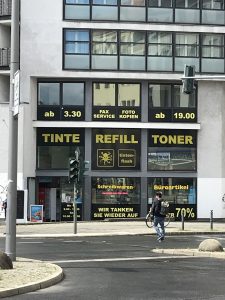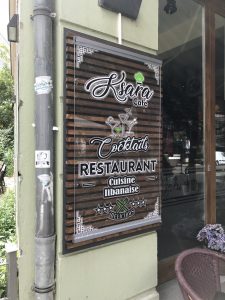The linguistic landscape of Berlin is one that communicates the growing importance of English to the German economy while holding on to the German language roots that construct the foundation of the city. Although the vast presence of the English language in Berlin is undeniable, it’s clear that the German local population puts great value in their native language.
Berlin is a city of many languages. German, of course, is the most commonly heard on the street. This is true in any neighborhood, even ones with large immigrant populations such as Kreuzberg. In areas that wouldn’t be considered ‘tourist areas’, it is relatively uncommon to have English translations on road signs or shop windows. Public transportation signs and storefronts are almost always in German. And, even when Germans are fluent in English and they are confronted with someone who is clearly an English speaker (for example, a group of Americans speaking English), that German will typically still try to speak German to them. Additionally, it is important to acknowledge the variable of public vs. private spaces, just as Leeman and Modan do (Leeman & Moden, 2009). There’s definitely a difference in the languages you’ll see and hear depending on what kind of space you’re in. In public spaces, German is very common, and there is not much English to be found. In private owned spaces, like stores or restaurants, there’s more German than English, but most people speak English and you’ll hear it more often. Most signage will be in German, but the employees and customers speak English freely. At first glance, it may appear to be a monolingual environment but it is actually a multi-lingual mixing pot. In public buildings like city museums, you’ll see lots of English, catering to tourists.
One of the most interesting things about Berlin is that when English does appear on signs, it is usually casually mixed into German. Instead of there being two separate translations of German and English, there will be one sign with the two languages mixed together. The two images attached to this blog post are examples of this. The first, a copy shop, has both German and English mixed together on the storefront. The second, a restaurant, mixes a predominantly English sign in with the German spelling of “Lebanese”. This integrated language landscape points towards how deeply rooted English has become in Berlin, with the two languages interchangeably flowing back and forth.


English has a strong hold on business life in Berlin. As Leeman and Moden explain, the shape of a linguistic landscape can tell us a lot about the power dynamics of an environment. Because of the tourism industry in Berlin and the quickly expanding tech and startup industries, the integration of the English language was inevitable. Any workplace in Berlin that has some reach beyond Germany will generally conduct itself in English. Even workplaces that only operate in the German-speaking region in Europe will speak primarily English. For example, I work at a clean-tech startup accelerator here in Berlin. Even though the accelerator only coordinates startups in Germany, Austria, and Switzerland, all business is conducted in English and they only taken English language applications. At all museums or tourist sites, everything has an English translation. These are examples of the power of English in the Berlin economy. It helps connect across borders and draw in money from travellers.
The linguistic landscape of Berlin is telling or the economic and cultural conditions of the city. It is one with a large immigrant population and a young international tech industry. It is one with great pride in its native language. It is one looking to take as much advantage of tourism dollars as possible. The presence of German and English in Berlin tell a story of the way English has been integrated into Berliner life in order to advance the development of the area. The power of English as a money making tool and an international business language has allowed it to take a strong hold of Berlin. But, the native pride in the German language has ensured that whenever possible, German is used rather than English.
Works cited:
Leeman, Jennifer and Gabriella Modan. 2009. “Commodified Language in Chinatown: A contextualized approach to linguistic landscape.” Journal of Sociolinguistics, 13(3): 332-362.
